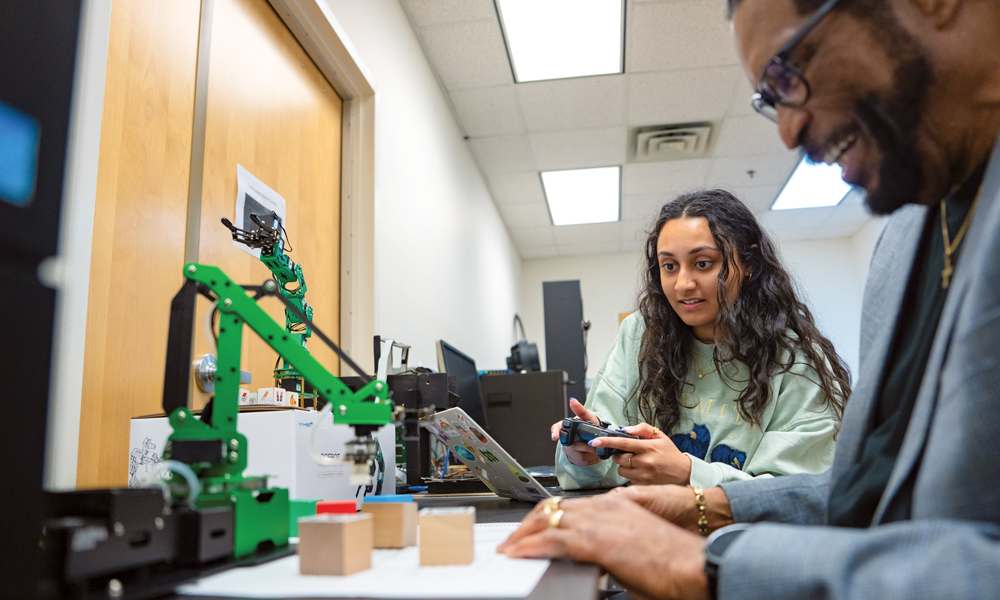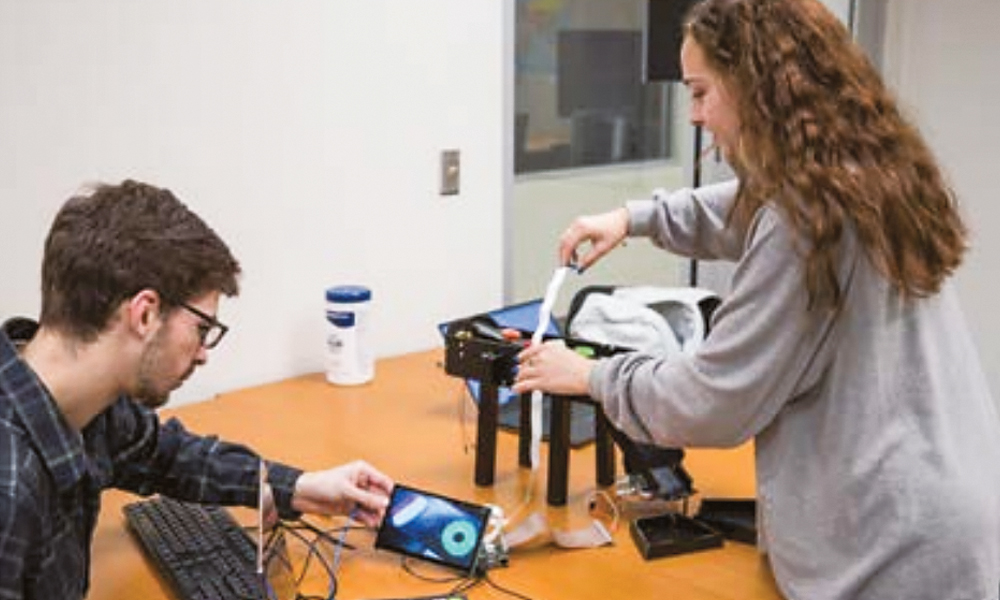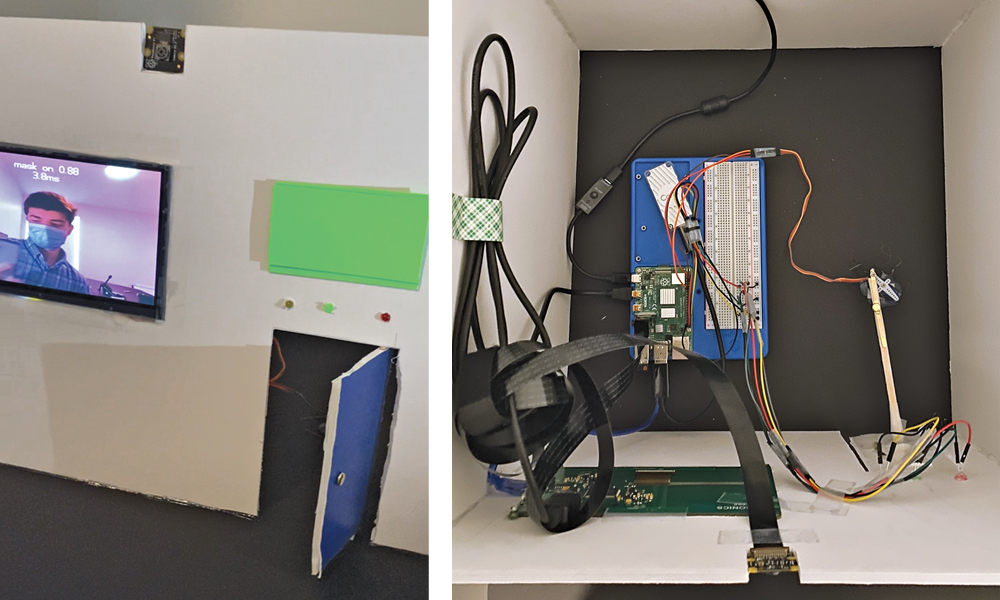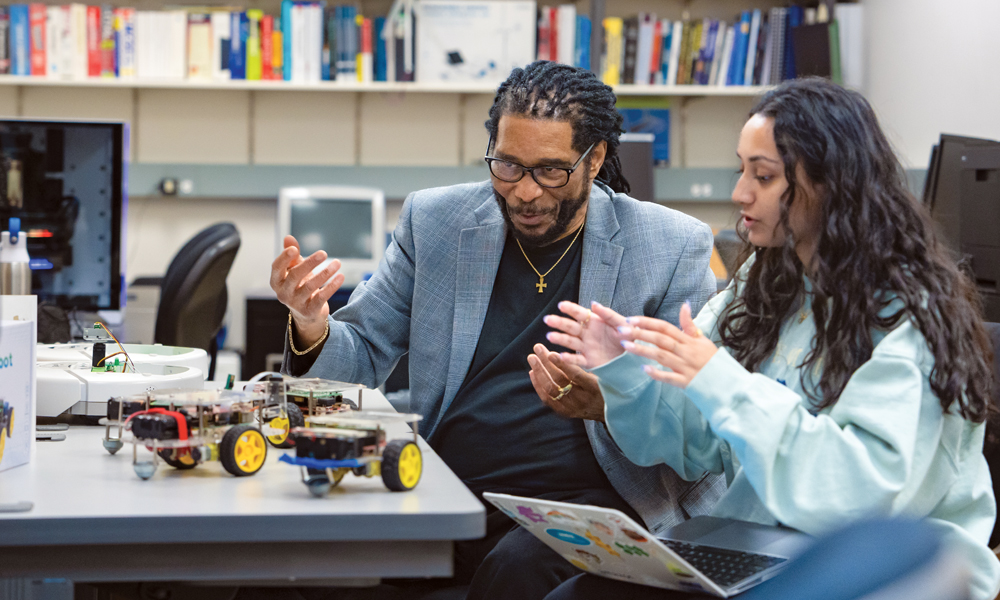The power of AI in the classroom
ISAT program preparing students for the latest in machine-learning technology
Science and Technology
SUMMARY: As JMU adds more classes that focus on AI and machine-learning models, students interested in engineering and data science have realized new passions for working with the latest technology during their studies and in their careers. Tony Teate, Integrated Science and Technology professor and director of the Data Science and Applied Machine Learning Laboratory at JMU, hopes to keep growing the department, attracting more experts in the field and offering the latest in machine-learning efforts.
Hear more episodes and subscribe to the podcast at the Being the Change podcast page.
Claire Timmins (’22) was working with artificial intelligence in her third year at JMU when she felt her education level up. Having switched from an Engineering major to a major in Integrated Sciences and Technology, Timmins recalled the program being a better fit for her interests. But school was still just school until Tony Teate, professor of ISAT and director of Madison’s Data Science and Applied Machine Learning Laboratory, challenged her to switch capstone projects.
She moved from an environmental-based team project to a coding project with classmate Noah Munis (’22). Timmins said she thought the challenge could offer a bigger opportunity and open more doors after graduation. “That was the first time I ever felt passionate about school,” Timmins recalled. “It made me realize, wow, I’ve never felt this way about a project or about a class, where I was unconditionally focused, determined.”

Photo courtesy of Timmins (’22)
With Teate’s support, Timmins and Munis developed and implemented an automated computer vision-driven sorter, and she recalled them working day and night to teach their algorithm to recognize different types of packaged hard candies from more than 100 photos. After months of research and testing, they were excited when everything clicked into place. “When we finally got the camera to recognize our images, it was the best feeling,” she said.
Timmins, who now works in Arlington, Virginia, as a technology consultant on Oracle Services and Energy Services with the accounting firm Ernst & Young, appreciates that the ISAT program allowed her to tailor her degree to her interests. “You may like something but then kind of want to veer it in a different way than the curriculum asks you to, and you’re totally allowed to if you incorporate those classes,” she said. “That’s what really made my education experience at JMU epic.”
***
John Fellenbaum Jr. (’21), of Haymarket, Virginia, researched his capstone project during the height of the COVID-19 pandemic, opting to partner with his cousin, Garrett Jackson (’21), of Vienna, Virginia, on a machine-learning model that could identify if a person was wearing a mask using image classification, then send an electrical pulse to a servo motor to open the door.

Photos courtesy of Fellenbaum (’21)
The two ISAT majors taught their model through the ML platform TensorFlow Lite, using more than 3,000 images of themselves with and without masks, achieving a response time of no longer than 3 milliseconds before the model would send an electrical pulse to the servo motor that would open or close the door as well as turn on a light to indicate whether a subject was or wasn’t wearing a mask.
“With any kind of technology, it’s rare that everything just works perfectly the first time. It’s always exciting once it’s actually working properly,” Fellenbaum said. “Getting the light to turn on for the first time, that was a rush. That felt good, ’cause that took a while. It was the simplest thing, and most of the time it is the simplest thing.”
Another favorite lesson was a lab that involved speech recognition, in which the students recorded themselves speaking and the model named which emotion they were using. “It would use the soundwaves of your audio and run that through the model,” Fellenbaum said. “Once that actually finally worked out, it was pretty cool.”
|
“With any kind of technology, it’s rare that everything just works perfectly the first time. It’s always exciting once it’s actually working properly.” — John Fellenbaum Jr. (’21) |
Fellenbaum, who chose a degree program in ISAT with a concentration in Information and Knowledge Management, switched from computer science in his second year. Though ISAT was a better fit, he recalled his interest growing as he took more upper-level courses. “It more than met my expectations,” he said. “It was just really cool stuff.”
For fourth-year student Aarushi Sharma, discovering the applications of AI and ML have made all the difference in her studies, particularly in Teate’s Machine Learning and Data Science class, which focuses on the technical aspects of the subject matter. “In my other AI classes, the focus was on what could be created, but this class focused on the how,” the Aldie, Virginia, resident said.
The class covers a common issue of working with AI called the black box problem, which Sharma said refers to “the inability to completely understand what happens in [an] ML model, the black box, when a decision is being made.” Students can provide the model with input and receive output, but it isn’t clear how the AI reaches its decision.
She said Teate is skilled at breaking down the steps that different algorithms take to arrive at their decisions. “By explaining complex subjects in a digestible manner and encouraging students to do the work of AI by hand, we are able to understand how a model should work,” Sharma said. “This class really helped me demystify the workings of AI and also gave me perspective on the reliability of it.”
|
“By explaining complex subjects in a digestible manner and encouraging students to do the work of AI by hand, we are able to understand how a model should work.” — Aarushi Sharma, student |
Another project, by Virginia Beach resident Joy Williams (’19), was to develop an Android app that used ML to train an algorithm using about 25,000 medical images to determine whether skin anomalies were cancerous or benign. During the 2018-19 academic year, nothing was readily available in the Google Play store, she said. Her app’s accuracy was about 70%, and Teate said the project was a “big undertaking” and hinted at the larger world of concerns that AI can help with.
Williams was one of JMU’s first ISAT students to work with AI in a capstone project. She recalled having heard about AI and ML in the media, but it all sounded like the stuff of science fiction until she started taking classes with a concentration in Information and Knowledge Management.
She recalled Teate asking her and some other data-science students if they would want to take a course like that in their fourth year if he created one. “It was just an opportunity that we couldn’t pass up,” Williams said. Teate then thought up the idea for the app, and Williams worked with him to create one.
Now a software engineer at Mutual of Omaha and a previous software developer for Freddie Mac, Williams said she’s learned since leaving JMU that the corporate world is a little slow to adopt new technologies. “It’s kind of this abstract idea,” she said. “I don’t even feel like AI and ML have been at the forefront of their minds.” But she’s looking forward to when it will be. When that happens, she said, “hopefully I can be at the forefront.”
***

Photo by Olive Santos (’20)
In 2016, very few JMU professors were working in AI, Teate said. At that time, he began to develop a series of courses in the Applied Computing concentration within the ISAT program to teach students the fundamentals of ML and data science. Students chose a capstone project, conducted the research, wrote a thesis, gave a presentation to their colleagues and invited guests as the culmination of their ISAT degree.
Though designed years ago, these courses have successfully prepared students for the latest in ML technology, Teate said. “[Implementing AI] needs to be done at all levels of education now,” he said. “It makes me feel good that I got a head start on it.”
ISAT students declare a concentration in one of six areas: Applied Biotechnology, Applied Computing, Energy, Environment and Sustainability, Industrial and Manufacturing Systems, and Public Interest Technology and Science. These choices have given students a broad range of areas in which to be impactful in society, Teate said — “empowering students to help make the world a better place.”
|
“That was the first time I ever felt passionate about school. ... I was unconditionally focused, determined.” — Claire Timmins (’22) |
More recently, course additions have allowed students to begin research on their capstone projects at the beginning of their third year instead of waiting until the second semester of that year, allowing them two full years to learn more about AI and ML technology while at JMU.
ISAT now has a course developed by Teate called Emerging Topics in Applied Data Science, allowing students to explore advanced technologies such as deep ML and generative AI (such as ChatGPT). Another ISAT program, Intelligence Analysis, also offers courses in AI and how it can provide decision support for the U.S. Intelligence Community.
AI is the wave of the future, Teate said, and he wants to prepare his students for how it will impact their career paths. “The cat is out of the bag now, and there’s just no way to put it back in.”
The increase of AI-related courses at JMU has been part of a recent push to include more data-science topics in the university curriculum. Toward the end of the Spring 2018 semester, the Office of the Provost charged a task force with creating a modern, undergraduate data-science major at the university, allowing JMU to stand out among institutions that only offer similar courses at the graduate level.
Teate, who holds a doctorate in engineering and physics, co-chaired this task force, whose efforts culminated in the formation of a search committee that hired a cohort of seven new faculty members to develop and teach a new Environmental Data Science major.
In addition to his service on the Data Science Task Force and search committees, Teate has also been active in AI research himself. One of his recent efforts has been the development of ML models for the design of new semiconductor materials. The purpose of these materials is to split water into hydrogen and oxygen, and to use the hydrogen in fuel cells as a clean energy source.
His research approach has evolved to use AI, which delivers much better results than any of the methods he had previously used. He recalled that when he gave a talk at the Applied Machine Learning Conference in Charlottesville, Virginia, on the subject in the Spring 2019 semester, attendees were impressed with his novel approach to discovering new materials. “I would love to see that kind of research being pervasive,” Teate said.
|
“We need professors who understand generative AI and how to prompt these models to get the best responses.” — Tony Teate |
With the fields of AI and ML changing so fast, Teate said his courses evolve each year as different technologies become available. Recent changes include new ML techniques and datasets from areas such as medicine and social science, giving students a base of understanding for their chosen career paths. “I curate those datasets, which is the hardest part,” Teate said.
This year, he added prompt engineering to his Emerging Topics course, including ChatGPT and Bard — large language models that can facilitate the development of deep learning models in the classroom. “This is an emerging topic that is not only exciting but is going to be quite useful,” Teate said.
As JMU becomes more research-oriented, he said, “we need professors who understand generative AI and how to prompt these models to get the best responses.”
He also sees prompt design and prompt engineering contributing to a new, competitive job market in the near future. “When you’re really good at prompt engineering, it’s anticipated that those jobs will pay well,” he said, with a starting annual salary of $100,000 that will extend upward of $300,000. “That really is an emerging field.
It’s really important, so we need to be on top of that.”
|
“[AI is] kind of scary for a lot of people, especially if they’re not in the tech industry. … It’s definitely a beneficial tool that we can use in our everyday lives.” — Joy Williams (’19) |
Williams said AI can be “kind of scary for a lot of people, especially if they’re not in the tech industry,” But she’s convinced that, through research, people will “find compelling evidence that it’s definitely a beneficial tool that we can use in our everyday lives.”
She and Fellenbaum urge people not to accept fear-based explanations of AI in the media but to conduct their own research on how it can work for them. “They shouldn’t be afraid of it or afraid to use it,” Fellenbaum said. “In regards to autonomous vehicles, AI eliminates the human error. It’s not going to text and drive.”
Working from her Ballston, Virginia, apartment, Timmins implements databases for clients, configuring the systems for their preferences, so her clients and their customers can start and stop utility services with the push of a button.
“AI is designed to think as we do, so it’s programmed by people to think like people,” Timmins said. AI can assess a problem like a burst or leaking pipe and, within seconds, make a rational decision on what to do with the information. “It can think exactly how we do but much quicker,” she said, which “saves a lot of time and a lot of money for a lot of companies.”
But as much as AI can do, Sharma cautioned that its abilities only extend as far as its programming allows. “With the emergence of AI to the general public, I think it’s really important that individuals are aware of the lack of reliability with AI,” she said.
“Although models can be trained to have accuracy ratings as high as 99.99%, there is always a chance for error. Because AI obtains information from preexisting content, it is also able to obtain biased or wrong information ... It’s always good to take AI response with a grain of salt.”

